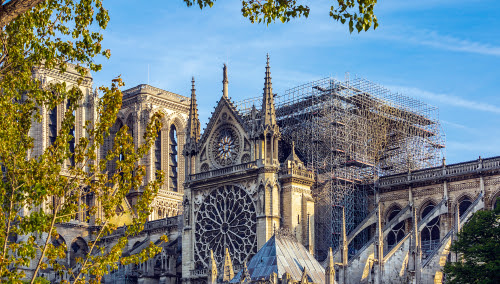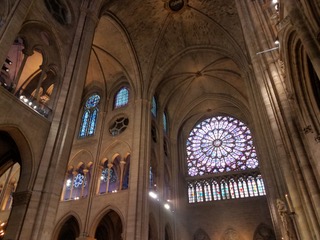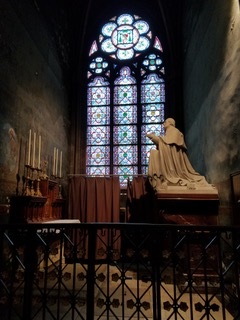 Samuel T. Francis
Samuel T. Francis
Championing
Western Civilization
and the great legacies of
Sam Francis and Joe Sobran
and their allies
 Joseph Sobran
Joseph Sobran
FGF Op-Ed
“Heretical” Ideas
April 15, 2020
[Publisher’s Note: Today is the first anniversary of the fire
at Notre Dame cathedral in Paris]

One Year Later: The Fire at Notre Dame
Eastertide Reflections
by Harley Price
Fitzgerald Griffin Foundation
Toronto, Canada, Priceton.org, April 21, 2019 — Like a multitude of others, apparently, I was taken aback by the intensity of my reaction to the news of the fire at Notre Dame in Paris. Until it was ascertained that the great rose windows in the transepts and west front had been spared, Mrs. P. and I were on what was rather like a death vigil for an old friend.
Throughout the Middle Ages, churches burned, and then they rose again from their own ashes, like the phoenix of the medieval bestiaries, the mythical bird that became a natural type of Christ’s Resurrection.
The 13th-century rose windows enclosed practically the only painted glass that the anti-religious fanatics of the French Revolution — the secular forerunners of the Taliban — were unable to reach. (Much of the rest of the current structure, including hundreds of stone sculptures and dozens of windows, is the product of a 19th-century “restoration” by the erudite, but sometimes hyperactive, architect Viollet-le-Duc.)
The besetting fear was that the lead câme securing thousands of pieces of painted glass might melt, even from the radiant heat of distant flames, and the glass would return to its sandy elements on the nave floor a hundred feet below.
When all but the west front of the new structure was destroyed again by fire in 1194, the magnificent cathedral that still stands was begun.
Throughout the Middle Ages, churches burned, and then they rose again from their own ashes, like the phoenix of the medieval bestiaries, the mythical bird that became a natural type of Christ’s Resurrection. In the late 1130s, after the previous 11th-century church had been devastated by fire, construction commenced on a new, grander edifice at Chartres. When all but the west front of the new structure was destroyed again by fire in 1194, the magnificent cathedral that still stands was begun. As a highly combustible material object, the medieval church is an apt symbol of worldly mutability and transience, as expressed in the double connotation of the Christian liturgical formula “ashes to ashes.”
As a highly combustible material object, the medieval church is an apt symbol of worldly mutability and transience, as expressed in the double connotation of the Christian liturgical formula “ashes to ashes.”
Our own modern interpretation of architectural renewal is rather different from the medieval, which is one of the reasons, no doubt, for the widespread anxiety that the damage at Notre Dame might have been plenary. A completely new cathedral rising from the ashes of the old would probably have resembled the Pompidou Centre, the pyramidal “crystal” at the Louvre, or any other of those daring experiments in conformism and vapidity that so fetch architects and urban planners today, none of whom seems to have recognized that the reason tourists flock to their cities in the first place is that the medieval and Renaissance buildings they come to see are so aesthetically retrograde.
No such fear would have discomposed the medieval peasant whenever a new cathedral was being contemplated. However much art historians obsess over the technical or stylistic novelties associated with the distinct periods of medieval ecclesiastical design (Early Christian, Romanesque, High Gothic, Late Gothic), what is overwhelmingly plain is the unbroken continuity of architectural syntax (nave; aisle; transept; choir; pier; column; pilaster; arcade; entablature; tribune; clerestory; vault). As understood until recently, renovatio (structural, intellectual, or spiritual) is predicated on looking backward in gratitude to the harmonious beauty of the past (with the emphasis always on the re, not the nova).
 The magnificent (former) ceiling of Notre Dame;
The magnificent (former) ceiling of Notre Dame;
and a gigantic rose window (which survived the fire)
Photo by Fran Griffin
Anagogy
For Suger as architect, every “stone” and piece of glass in his new church was likewise a “light” that lifted up the observer to the contemplation of the Light of lights.
When a “new” monastic church was being planned in the 1130s just north of Paris at St. Denis — which was to become, in fact, the innovative prototype of the Gothic — its brilliant architect Suger (also theologian, poet, and abbot of St. Denis) looked decidedly backward for his inspiration to the writings of the late–5th-century Syrian mystic known as the Pseudo-Dionysius (who Suger assumed was even more ancient, since he was identified by tradition with the 1st-century Dionysius the Areopagite supposed to have been converted in Athens by St. Paul, as recorded in the Book of Acts).
Here is a passage from Suger’s Commentary on the Pseudo-Dionysius’s seminal Celestial Hierarchy, showing how palpably it enflamed Suger’s architectural imagination:
Every creature, visible or invisible, is a light brought into being by the Father of lights.... This stone or that piece of wood is a light to me.... For I perceive that it is good and beautiful; that it exists according to its proper rules of proportion; that it differs in kind and species from other kinds and species; that it is defined by its number, by virtue of which it is “one” thing; that it does not transgress its order; that it seeks its place according to its specific gravity. As I perceive such and similar things in this stone they become lights to me, that is to say, they enlighten me. For I begin to think whence the stone is invested with such properties...; and soon, under the guidance of reason, I am led through all things to that Cause of all things which endows them with place and order, with number, species and kind, with goodness, beauty, and essence, and all other divine bequests.
As described in the liturgy of the medieval dedication ceremony, the church is above all a symbol of no earthly city, but of the Celestial Jerusalem. That, again, is its “anagogical” function: to make you look upward, from the visible to the invisible.
For Suger as architect, every “stone” and piece of glass in his new church was likewise a “light” that lifted up the observer to the contemplation of the Light of lights. As Suger writes in his invaluable analysis of the architecture of the new church, describing his rapture upon seeing the precious stones that glowed on the main altar,
When — out of my delight in the beauty of the House of God — the loveliness of the many-coloured gems has called me away from external cares, and worthy meditation has induced me to reflect, transferring that which is material to that which is immaterial, on the diversity of the sacred virtues: then it seems to me that I see myself dwelling, as it were, in some strange region of the universe which neither exists entirely in the slime of the earth nor entirely in the purity of Heaven; and that, by the grace of God, I can be transported from this inferior to that higher world in an anagogical manner.
And in a poem explaining the doors of the west portal which, in gilt-bronze relief, depicted the Passion, Resurrection, and Ascension:
Marvel not at the gold and the expense but at the craftsmanship of the work.
Bright is the noble work; but, being nobly bright, the work
Should brighten the minds, so that they may travel, through the true lights,
To the True Light where Christ is the true door.
In what manner it be inherent in this world the golden door defines:
The dull mind rises to truth, through that which is material.
 A side altar at Notre Dame (before the fire)
A side altar at Notre Dame (before the fire)
Photo by Fran Griffin
The Vandals of Post-Modernism
Might not humans … retain some vestigial, archetypal awareness that they are not merely creatures of matter and time, an awareness that the prospect of the loss of a building such as Notre Dame has dimly reawakened into consciousness?
We have heard any number of glib analyses of the mood of prayerful concern that descended over the world in the hours following the outbreak of the fire at Notre Dame, including that it has always been a beloved “tourist symbol of Paris” (to be checked off, one supposes, after the Eiffel Tower). This is especially and ironically anodyne in that, as described in the liturgy of the medieval dedication ceremony, the church is above all a symbol of no earthly city, but of the Celestial Jerusalem. That, again, is its “anagogical” function: to make you look upward, from the visible to the invisible.
In a materialist, post-Christian age, in which the visible and literal — as opposed to the invisible and symbolic — are the only accepted realities (and everyone is in any case looking downward at the selfies they’ve just taken on their iPhones, with buildings such as Notre Dame subordinated as background to their own cosmic grandeur), one does not expect the ordinary Parisian to understand anagogy. But then, how can one account for the emotional effect of the fire? Might not humans, even in this secular epoch, retain some vestigial, archetypal awareness that they are not merely creatures of matter and time, an awareness that the prospect of the loss of a building such as Notre Dame has dimly reawakened into consciousness?
Like Notre Dame, medieval churches are thus celebrations and fortresses of the religious, intellectual, and moral traditions and norms that have sustained Western Civilization since antiquity, and are now everywhere under attack by the vandals of post-modernism. Isn’t the potential loss of that, too, what the people of Paris and throughout the world were — at least subliminally — mourning?
The medieval church, moreover, has been fittingly described as a “summa in stone.” As the eminent medievalist and art historian Émile Mâle has pointed out, the Middle Ages was the age of the encyclopedia, and the medieval church, an encyclopedia in visible form, is a veritable compendium of all human wisdom and knowledge. In sculpture and glass at Paris, Chartres, and throughout Europe, we see emblems and personifications of every human art, craft, and industry, of the liberal disciplines (literature, philosophy, oratory, arithmetic, geometry, astronomy, music) of the ancient and medieval curriculum, of the virtues and vices that conduce to a life of happiness or misery.
Like Notre Dame, medieval churches are thus celebrations and fortresses of the religious, intellectual, and moral traditions and norms that have sustained Western Civilization since antiquity, and are now everywhere under attack by the vandals of post-modernism. Isn’t the potential loss of that, too, what the people of Paris and throughout the world were — at least subliminally — mourning?
###
Copyright @ 2025 by Harley Price and the Fitzgerald Griffin Foundation. You may re-post if a live link is given to this article; or reprint if credit is given to Harley Price and fgfBooks.com. This is one of the essays in an anthology of Harley Price’s articles, Give Speech A Chance: Heretical Essays on What You Can’t Say or Even Think to be published by FGF Books.
Harley Price has taught courses on literature, philosophy, and religion at the University of Toronto, Tyndale University College, and the University of Toronto’s School of Continuing Studies from the academically novel perspective that the great writers and thinkers of the Western Tradition, from Homer to Milton, Plato to Pico, have something to teach us.
Dr. Price’s political and social commentary has appeared in Our Canada, The Idler, The Interim, Catholic Insight, and The Epoch Times. His fortnightly “Essays in Reaction to the Smelly Little Orthodoxies of the Day,” and “Essays on The Perennial Things,” may be read on his website, Priceton.org.
Help the Fitzgerald Griffin Foundation in its mission to publish the writings of Joe Sobran, Sam Francis, Harley Price and other great writers. Consider a tax-deductible donation to FGF online.
Or send a check to: Fitzgerald Griffin Foundation344 Maple Avenue West, #281
Vienna, VA 22180
1-877-726-0058
publishing@fgfbooks.com
Or call toll-free at 1-877-726-0058 to donate by phone. For more information, write to Fran Griffin at fgf@fgfBooks.com